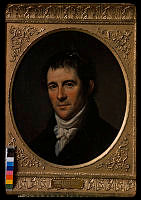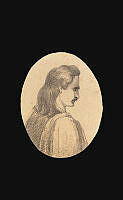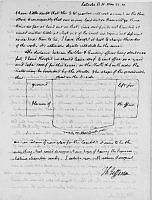Rubenstein Center Scholarship
A Prominent Early White House Neighbor

The Splendid Mrs. Madison, by Peter Waddell, depicts the Oval Room of the White House during the administration of President James Madison. Commodore Decatur, in uniform, appears in the center of the painting.
Peter Waddell for the White House Historical AssociationWhen Commodore Stephen Decatur and his wife, Susan, moved into their new three story brick home across from the White House in 1819, they desired to link their futures with that of the growing national capital. It is no coincidence that they chose to reside in such close proximity to the Executive Mansion.
One of the nation’s first post-Revolutionary War heroes, Stephen Decatur arrived in Washington already a well-known military figure. He had distinguished himself in both Tripoli Wars as well as the War of 1812. Because of his experience, and in part due to his desire to be stationed somewhere on land as opposed to being constantly at sea, he was selected to a position on the prominent Board of Naval Commissioners in Washington, D.C.1 His duties included managing the expanding U.S. Navy as well as preparing recommendations for the future defense of the Chesapeake Bay, as damaging British excursions during the War of 1812 had demonstrated the Bay’s vulnerability.
Upon arriving in Washington, D.C., the Decaturs soon fell in with the fashionable city elite. Margaret Bayard Smith, a Washington socialite and author, recalled at one social affair seeing Susan Decatur sitting with First Lady Dolley Madison and Mrs. Monroe “and a dozen other ladies in a formidable row.”2

Susan Decatur (1776-1860), wife of Commodore Stephen Decatur.
Painting on loan from Priscilla Machold Loeb and FamilyThe Decaturs commissioned Benjamin Henry Latrobe, America’s first professional architect and engineer, to design a home “fit for entertaining.” Workers began preparing the site for the Decaturs in January 1818. The completed house opened in 1819 and was a splendid residence on ground purchased by Decatur close to the White House. The Decaturs entertained and were entertained throughout the president’s neighborhood and were friendly with President James Monroe and those in his administration. 3 One White House visitor recalled seeing Commodore Decatur at a White House dinner “graced the feast with his attendants in full uniform.” 4
The Commodore’s future in Washington, D.C. was cut tragically short from wounds he received from a duel with Commodore James Barron. The duel was a culmination of growing hostility between the two over Barron’s role in the embarrassing 1807 Chesapeake-Leopard Affair and subsequent damage to Barron’s professional reputation. Just before the duel, Stephen and Susan Decatur hosted a ball at their house in celebration of President Monroe’s daughter Maria’s marriage to Samuel Lawrence Gouverneur. Their wedding took place in the White House on March 9, 1820. One observer afterward commented upon Decatur’s melancholy demeanor in the days preceding his encounter with Barron. 5
On the morning of Wednesday, March 22, Decatur left his home for the dueling grounds near Bladensburg, Maryland, northeast of Washington. The altercation resulted in the mortal wounding of Commodore Decatur, with Barron also being wounded. Decatur returned to his home on Lafayette Square, to die from his wounds later that night with Mrs. Decatur in inconsolable grief. Throughout the day, Washingtonians had gathered outside Decatur House, anxious for news regarding his condition. 6

Commodore Stephen Decatur (1779-1820), in a circa 1815 portrait.
White House Historical AssociationAfter Decatur’s death, a poem appeared in a Washington newspaper titled, “The Death of Decatur” that lamented, “Columbia! Was that heart thine own—As bright a star as decks thy brow: Then mourn, for, lo! Thy gallant son.” 7 Washington City nearly shut down upon news of Decatur’s death, with President James Monroe calling off his usual afternoon reception. The 16th Congress also adjourned for members to attend his funeral and for the remainder of the session, members wore black crapes on their left arms as a symbol of mourning. 8 Lavish parties planned by the elite of Washington for Maria Monroe Gouverneur were put on hold. On March 24 President Monroe, along with Decatur’s former colleagues and friends in the Navy and thousands of citizens, took part in his funeral procession. 9
Decatur’s death at age forty-one profoundly shocked the country. As one of the nation’s premier heroes, Decatur’s loss had a powerful impact throughout the nation’s capital and beyond. Laments and expressions of grief appeared in newspapers throughout the expanding United States. Many counties and cities across the United States are named in Decatur’s honor.
Today, his former residence on Lafayette Square still draws visitors. As home to the David M. Rubenstein National Center for White House History, Decatur House hosts exhibitions highlighting the history of the nearby White House. Click here to learn more about visiting Decatur House.

Decatur House as it appears today, home of the David M. Rubenstein National Center for White House History.
White House Historical Association





















































